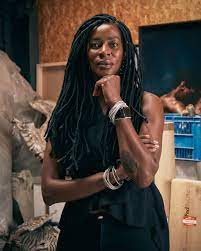South African artists you should know about
- Karla Cloete

- Oct 31, 2022
- 3 min read
By Karla Cloete
Edited by Imaan Moosa
From the first rise of impressionism to today’s Nike collabs, here are the artists from South Africa you should keep an eye out for.
1. Judith Mason
Judith Mason was born in Pretoria and studied at the University of the Witwatersrand (Wits), Michaelis School of Fine Art in Cape Town and later in Florence. She worked in oil, pencils, mixed media and printmaking. Her work is rich with symbolism and she dives deeply into mythology for inspiration.
A noteworthy artwork was her artistic contribution to the Truth and Reconciliation Commission (TRC) in 1998. Now in the Constitutional Court Art Collection, one such work was the Blue Dress dedicated to Phila Ndwanwe who was executed by security police. The blue dress is an homage to Ndwanwe who was stripped naked by the police.
As per her friend Kim Berman:

“I so clearly remember Judy’s exhibition of the TRC… those countless ribbons of shredded plastic of testimonies, tirelessly written in Judy’s hand, each word with the respect that honoured those painful stories. The depth of Judy’s empathy moved me so deeply as an artist and I remember understanding profoundly the power of art to reach deeply in one’s soul, as well as a recognition of how one can respond so purposely to life through art.”
She died in 2016 in White River. Watch this video to learn more about her work.
2. Nandipha Mntambo
Born in Swaziland, Nandipha Mntambo grew up and was schooled in South Africa where she studied at the University of Cape Town and Michaelis School of Fine Art.
Her work focuses on the female form and the feminine identity. Her sculptures feature natural materials which lend an honesty and organic feel to her work. She often uses her own body as mould, making the artwork personal. In certain pieces, cow hides blur the line between animal and human.
“The work I create seeks to challenge and subvert preconceptions regarding representation of the female body,” she says.

An iconic work created by Nandipha is her take on Ophelia. Ophelia has been rendered by artists since the day Shakespeare first penned her into being. But she’s never been played by an African woman. So, by placing herself in the role, Nandipha breaks open expectations of Western narratives.
Check out this video for a peak at the work where it resides in her sculpture garden.
3. Sir Zanele Muholi

Sir Zanele Muholi is a non-binary artist who specializes in photography. They hold a Masters of Fine Arts from Ryerson University, where they were also an honorary professor. Their work centres on race and sexuality, with the goal of increasing the visibility of queer communities in South Africa.
In 2019, they created a mobile studio with which they travelled across the country interviewing and photographing LGBTQ+ South Africans. The studio is called Brave Beauties, a celebration of trangender lives and stories.

“It’s my own way of writing South African LGBTQ+ history. So I don’t want to be limited by anything. I don’t want to be in any studio. I want to be unplugged,” says Zaneli.
Learn more about their organisation and community outreach programme Inkanyiso.
4. Karabo Poppy Moletsane
Karabo was born in Vereeniging and is a street artist, illustrator and graphic designer. She’s done everything from enormous murals to work for the Wall Street Journal. Karabo’s work is vibrant and lively with a distinctive flare. Her mission is to bring the African narrative to modern art, something she wasn’t taught about in art school.
Her murals are characteristic of her style: bright, bold and beautifully African.

“In the textbooks, there was traditional and primitive African art, nothing contemporary, or in the context of advertising or digitization,” she said. “I didn’t think anyone that came from where I came from would be listened to.”
Learn more about her full story from this article.
5. Maggie Laubser
Maggie Laubser is best known for bringing Expressionism to South Africa with other pioneers like Irma Stern. Focusing on the people and landscapes of the Western Cape, her work is incredibly vibrant and brings the techniques she learnt in Germany back home. Her works were at first heavily criticised, but after a decade or so they were rightfully embraced.

One of her notable artworks is Oestyd. It’s characteristic of her post-impressionist use of colour in form – capturing the light and movement of the active scene and the spirit of the region.
Here’s a video to learn more about her work.
From past to present our country boasts fantastic talent that should be celebrated.




















Comments